Critical Evaluation of Accounting Standards at Woolworths Australia
VerifiedAdded on 2023/03/17
|5
|1821
|70
Report
AI Summary
This report provides a critical evaluation of the accounting standards applied by Woolworths Australia. It begins with an overview of the Australian Accounting Standards Board (AASB) and its role in regulating accounting standards. The study examines the evolution of accounting standards in Australia, tracing its development and harmonization with international standards. The report then analyzes four articles, identifying common themes such as compliance, the role of standard-setting actors, and the influence of politics. Managerial implications are discussed, highlighting the impact of accounting standards on decision-making and risk management. The report also addresses limitations in the articles and suggests areas for future research, including the incorporation of technology and globalization. The conclusion summarizes the key findings and emphasizes the significance of accounting standards in the context of Woolworths' financial reporting.
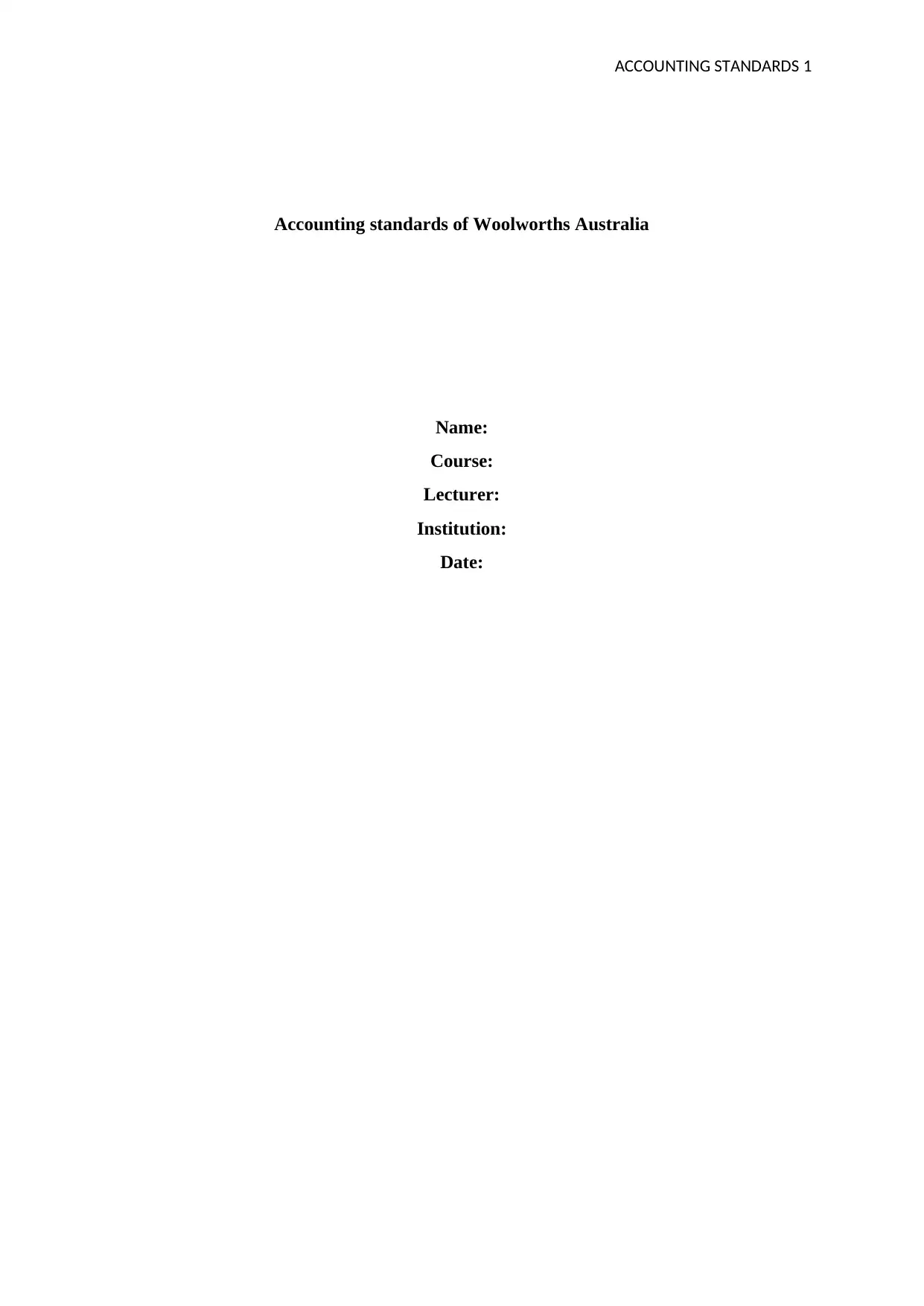
ACCOUNTING STANDARDS 1
Accounting standards of Woolworths Australia
Name:
Course:
Lecturer:
Institution:
Date:
Accounting standards of Woolworths Australia
Name:
Course:
Lecturer:
Institution:
Date:
Paraphrase This Document
Need a fresh take? Get an instant paraphrase of this document with our AI Paraphraser
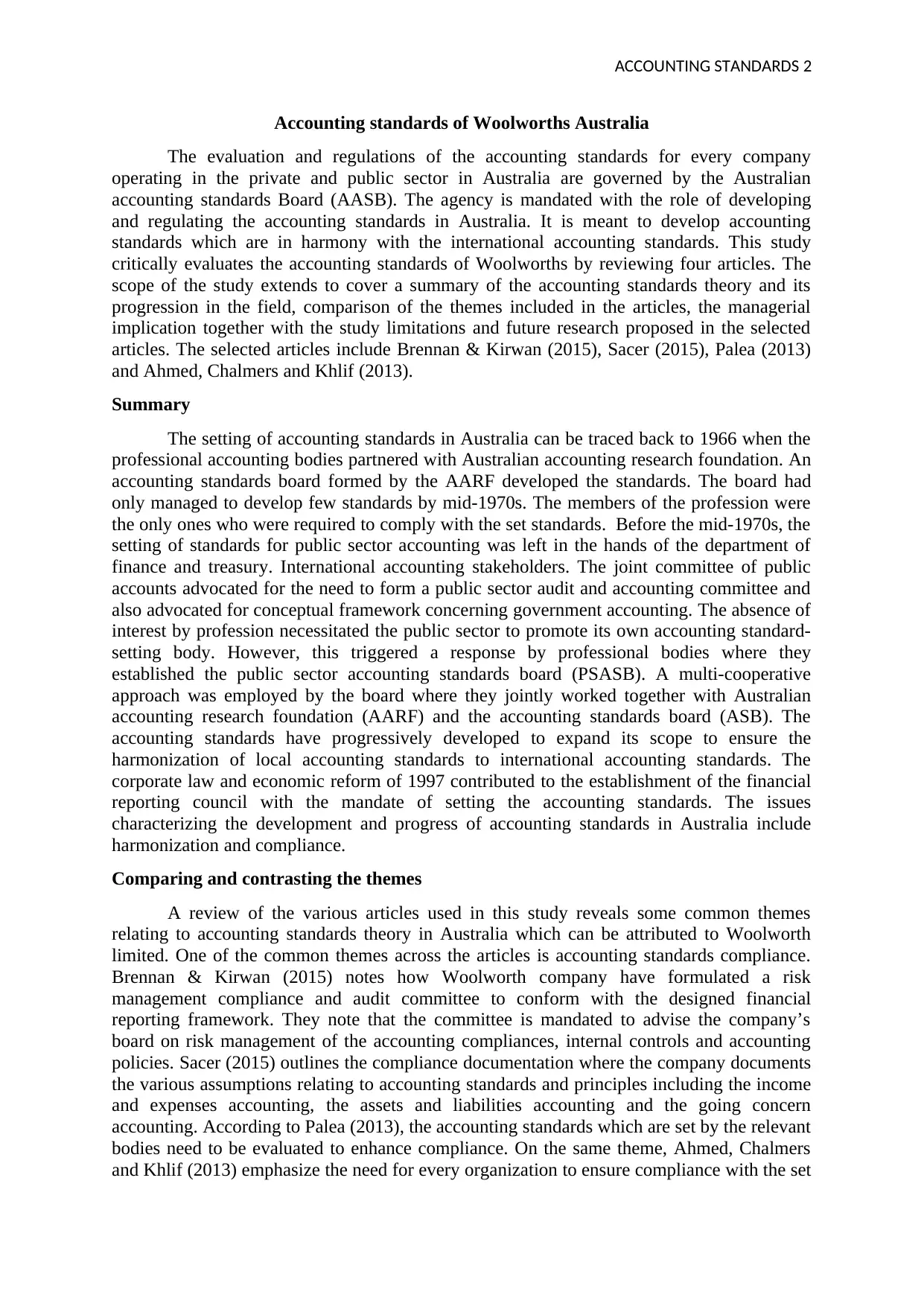
ACCOUNTING STANDARDS 2
Accounting standards of Woolworths Australia
The evaluation and regulations of the accounting standards for every company
operating in the private and public sector in Australia are governed by the Australian
accounting standards Board (AASB). The agency is mandated with the role of developing
and regulating the accounting standards in Australia. It is meant to develop accounting
standards which are in harmony with the international accounting standards. This study
critically evaluates the accounting standards of Woolworths by reviewing four articles. The
scope of the study extends to cover a summary of the accounting standards theory and its
progression in the field, comparison of the themes included in the articles, the managerial
implication together with the study limitations and future research proposed in the selected
articles. The selected articles include Brennan & Kirwan (2015), Sacer (2015), Palea (2013)
and Ahmed, Chalmers and Khlif (2013).
Summary
The setting of accounting standards in Australia can be traced back to 1966 when the
professional accounting bodies partnered with Australian accounting research foundation. An
accounting standards board formed by the AARF developed the standards. The board had
only managed to develop few standards by mid-1970s. The members of the profession were
the only ones who were required to comply with the set standards. Before the mid-1970s, the
setting of standards for public sector accounting was left in the hands of the department of
finance and treasury. International accounting stakeholders. The joint committee of public
accounts advocated for the need to form a public sector audit and accounting committee and
also advocated for conceptual framework concerning government accounting. The absence of
interest by profession necessitated the public sector to promote its own accounting standard-
setting body. However, this triggered a response by professional bodies where they
established the public sector accounting standards board (PSASB). A multi-cooperative
approach was employed by the board where they jointly worked together with Australian
accounting research foundation (AARF) and the accounting standards board (ASB). The
accounting standards have progressively developed to expand its scope to ensure the
harmonization of local accounting standards to international accounting standards. The
corporate law and economic reform of 1997 contributed to the establishment of the financial
reporting council with the mandate of setting the accounting standards. The issues
characterizing the development and progress of accounting standards in Australia include
harmonization and compliance.
Comparing and contrasting the themes
A review of the various articles used in this study reveals some common themes
relating to accounting standards theory in Australia which can be attributed to Woolworth
limited. One of the common themes across the articles is accounting standards compliance.
Brennan & Kirwan (2015) notes how Woolworth company have formulated a risk
management compliance and audit committee to conform with the designed financial
reporting framework. They note that the committee is mandated to advise the company’s
board on risk management of the accounting compliances, internal controls and accounting
policies. Sacer (2015) outlines the compliance documentation where the company documents
the various assumptions relating to accounting standards and principles including the income
and expenses accounting, the assets and liabilities accounting and the going concern
accounting. According to Palea (2013), the accounting standards which are set by the relevant
bodies need to be evaluated to enhance compliance. On the same theme, Ahmed, Chalmers
and Khlif (2013) emphasize the need for every organization to ensure compliance with the set
Accounting standards of Woolworths Australia
The evaluation and regulations of the accounting standards for every company
operating in the private and public sector in Australia are governed by the Australian
accounting standards Board (AASB). The agency is mandated with the role of developing
and regulating the accounting standards in Australia. It is meant to develop accounting
standards which are in harmony with the international accounting standards. This study
critically evaluates the accounting standards of Woolworths by reviewing four articles. The
scope of the study extends to cover a summary of the accounting standards theory and its
progression in the field, comparison of the themes included in the articles, the managerial
implication together with the study limitations and future research proposed in the selected
articles. The selected articles include Brennan & Kirwan (2015), Sacer (2015), Palea (2013)
and Ahmed, Chalmers and Khlif (2013).
Summary
The setting of accounting standards in Australia can be traced back to 1966 when the
professional accounting bodies partnered with Australian accounting research foundation. An
accounting standards board formed by the AARF developed the standards. The board had
only managed to develop few standards by mid-1970s. The members of the profession were
the only ones who were required to comply with the set standards. Before the mid-1970s, the
setting of standards for public sector accounting was left in the hands of the department of
finance and treasury. International accounting stakeholders. The joint committee of public
accounts advocated for the need to form a public sector audit and accounting committee and
also advocated for conceptual framework concerning government accounting. The absence of
interest by profession necessitated the public sector to promote its own accounting standard-
setting body. However, this triggered a response by professional bodies where they
established the public sector accounting standards board (PSASB). A multi-cooperative
approach was employed by the board where they jointly worked together with Australian
accounting research foundation (AARF) and the accounting standards board (ASB). The
accounting standards have progressively developed to expand its scope to ensure the
harmonization of local accounting standards to international accounting standards. The
corporate law and economic reform of 1997 contributed to the establishment of the financial
reporting council with the mandate of setting the accounting standards. The issues
characterizing the development and progress of accounting standards in Australia include
harmonization and compliance.
Comparing and contrasting the themes
A review of the various articles used in this study reveals some common themes
relating to accounting standards theory in Australia which can be attributed to Woolworth
limited. One of the common themes across the articles is accounting standards compliance.
Brennan & Kirwan (2015) notes how Woolworth company have formulated a risk
management compliance and audit committee to conform with the designed financial
reporting framework. They note that the committee is mandated to advise the company’s
board on risk management of the accounting compliances, internal controls and accounting
policies. Sacer (2015) outlines the compliance documentation where the company documents
the various assumptions relating to accounting standards and principles including the income
and expenses accounting, the assets and liabilities accounting and the going concern
accounting. According to Palea (2013), the accounting standards which are set by the relevant
bodies need to be evaluated to enhance compliance. On the same theme, Ahmed, Chalmers
and Khlif (2013) emphasize the need for every organization to ensure compliance with the set
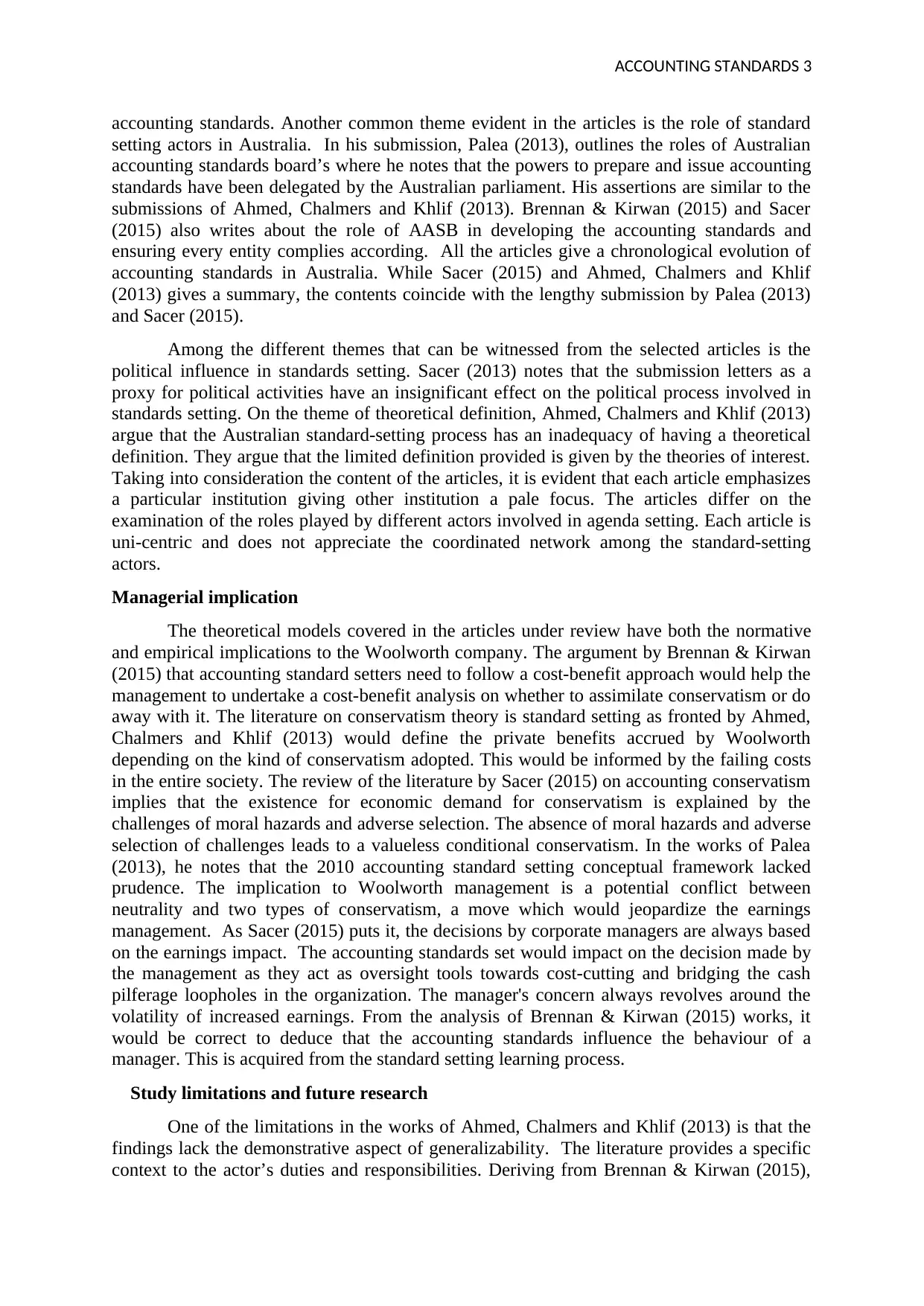
ACCOUNTING STANDARDS 3
accounting standards. Another common theme evident in the articles is the role of standard
setting actors in Australia. In his submission, Palea (2013), outlines the roles of Australian
accounting standards board’s where he notes that the powers to prepare and issue accounting
standards have been delegated by the Australian parliament. His assertions are similar to the
submissions of Ahmed, Chalmers and Khlif (2013). Brennan & Kirwan (2015) and Sacer
(2015) also writes about the role of AASB in developing the accounting standards and
ensuring every entity complies according. All the articles give a chronological evolution of
accounting standards in Australia. While Sacer (2015) and Ahmed, Chalmers and Khlif
(2013) gives a summary, the contents coincide with the lengthy submission by Palea (2013)
and Sacer (2015).
Among the different themes that can be witnessed from the selected articles is the
political influence in standards setting. Sacer (2013) notes that the submission letters as a
proxy for political activities have an insignificant effect on the political process involved in
standards setting. On the theme of theoretical definition, Ahmed, Chalmers and Khlif (2013)
argue that the Australian standard-setting process has an inadequacy of having a theoretical
definition. They argue that the limited definition provided is given by the theories of interest.
Taking into consideration the content of the articles, it is evident that each article emphasizes
a particular institution giving other institution a pale focus. The articles differ on the
examination of the roles played by different actors involved in agenda setting. Each article is
uni-centric and does not appreciate the coordinated network among the standard-setting
actors.
Managerial implication
The theoretical models covered in the articles under review have both the normative
and empirical implications to the Woolworth company. The argument by Brennan & Kirwan
(2015) that accounting standard setters need to follow a cost-benefit approach would help the
management to undertake a cost-benefit analysis on whether to assimilate conservatism or do
away with it. The literature on conservatism theory is standard setting as fronted by Ahmed,
Chalmers and Khlif (2013) would define the private benefits accrued by Woolworth
depending on the kind of conservatism adopted. This would be informed by the failing costs
in the entire society. The review of the literature by Sacer (2015) on accounting conservatism
implies that the existence for economic demand for conservatism is explained by the
challenges of moral hazards and adverse selection. The absence of moral hazards and adverse
selection of challenges leads to a valueless conditional conservatism. In the works of Palea
(2013), he notes that the 2010 accounting standard setting conceptual framework lacked
prudence. The implication to Woolworth management is a potential conflict between
neutrality and two types of conservatism, a move which would jeopardize the earnings
management. As Sacer (2015) puts it, the decisions by corporate managers are always based
on the earnings impact. The accounting standards set would impact on the decision made by
the management as they act as oversight tools towards cost-cutting and bridging the cash
pilferage loopholes in the organization. The manager's concern always revolves around the
volatility of increased earnings. From the analysis of Brennan & Kirwan (2015) works, it
would be correct to deduce that the accounting standards influence the behaviour of a
manager. This is acquired from the standard setting learning process.
Study limitations and future research
One of the limitations in the works of Ahmed, Chalmers and Khlif (2013) is that the
findings lack the demonstrative aspect of generalizability. The literature provides a specific
context to the actor’s duties and responsibilities. Deriving from Brennan & Kirwan (2015),
accounting standards. Another common theme evident in the articles is the role of standard
setting actors in Australia. In his submission, Palea (2013), outlines the roles of Australian
accounting standards board’s where he notes that the powers to prepare and issue accounting
standards have been delegated by the Australian parliament. His assertions are similar to the
submissions of Ahmed, Chalmers and Khlif (2013). Brennan & Kirwan (2015) and Sacer
(2015) also writes about the role of AASB in developing the accounting standards and
ensuring every entity complies according. All the articles give a chronological evolution of
accounting standards in Australia. While Sacer (2015) and Ahmed, Chalmers and Khlif
(2013) gives a summary, the contents coincide with the lengthy submission by Palea (2013)
and Sacer (2015).
Among the different themes that can be witnessed from the selected articles is the
political influence in standards setting. Sacer (2013) notes that the submission letters as a
proxy for political activities have an insignificant effect on the political process involved in
standards setting. On the theme of theoretical definition, Ahmed, Chalmers and Khlif (2013)
argue that the Australian standard-setting process has an inadequacy of having a theoretical
definition. They argue that the limited definition provided is given by the theories of interest.
Taking into consideration the content of the articles, it is evident that each article emphasizes
a particular institution giving other institution a pale focus. The articles differ on the
examination of the roles played by different actors involved in agenda setting. Each article is
uni-centric and does not appreciate the coordinated network among the standard-setting
actors.
Managerial implication
The theoretical models covered in the articles under review have both the normative
and empirical implications to the Woolworth company. The argument by Brennan & Kirwan
(2015) that accounting standard setters need to follow a cost-benefit approach would help the
management to undertake a cost-benefit analysis on whether to assimilate conservatism or do
away with it. The literature on conservatism theory is standard setting as fronted by Ahmed,
Chalmers and Khlif (2013) would define the private benefits accrued by Woolworth
depending on the kind of conservatism adopted. This would be informed by the failing costs
in the entire society. The review of the literature by Sacer (2015) on accounting conservatism
implies that the existence for economic demand for conservatism is explained by the
challenges of moral hazards and adverse selection. The absence of moral hazards and adverse
selection of challenges leads to a valueless conditional conservatism. In the works of Palea
(2013), he notes that the 2010 accounting standard setting conceptual framework lacked
prudence. The implication to Woolworth management is a potential conflict between
neutrality and two types of conservatism, a move which would jeopardize the earnings
management. As Sacer (2015) puts it, the decisions by corporate managers are always based
on the earnings impact. The accounting standards set would impact on the decision made by
the management as they act as oversight tools towards cost-cutting and bridging the cash
pilferage loopholes in the organization. The manager's concern always revolves around the
volatility of increased earnings. From the analysis of Brennan & Kirwan (2015) works, it
would be correct to deduce that the accounting standards influence the behaviour of a
manager. This is acquired from the standard setting learning process.
Study limitations and future research
One of the limitations in the works of Ahmed, Chalmers and Khlif (2013) is that the
findings lack the demonstrative aspect of generalizability. The literature provides a specific
context to the actor’s duties and responsibilities. Deriving from Brennan & Kirwan (2015),
⊘ This is a preview!⊘
Do you want full access?
Subscribe today to unlock all pages.

Trusted by 1+ million students worldwide
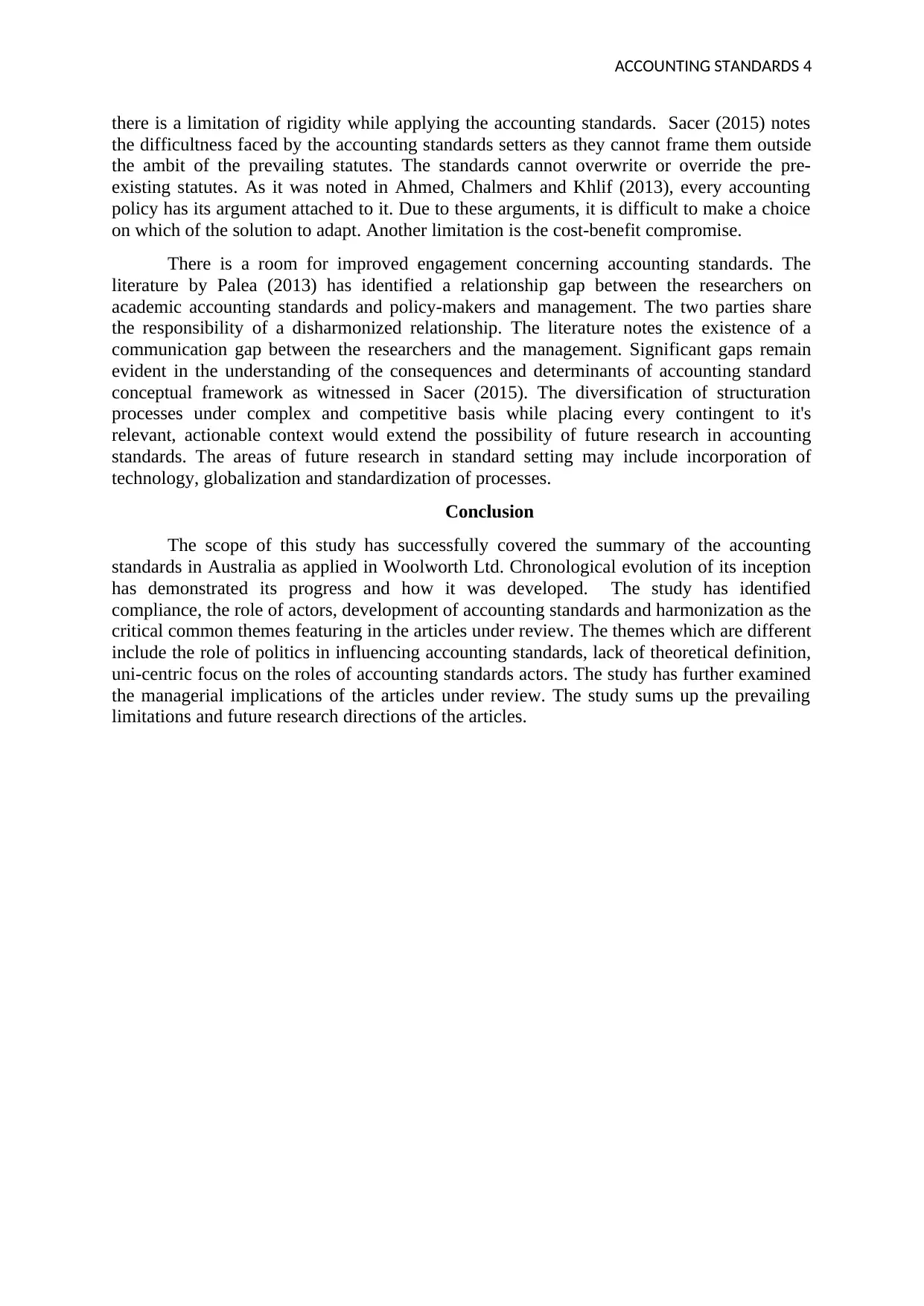
ACCOUNTING STANDARDS 4
there is a limitation of rigidity while applying the accounting standards. Sacer (2015) notes
the difficultness faced by the accounting standards setters as they cannot frame them outside
the ambit of the prevailing statutes. The standards cannot overwrite or override the pre-
existing statutes. As it was noted in Ahmed, Chalmers and Khlif (2013), every accounting
policy has its argument attached to it. Due to these arguments, it is difficult to make a choice
on which of the solution to adapt. Another limitation is the cost-benefit compromise.
There is a room for improved engagement concerning accounting standards. The
literature by Palea (2013) has identified a relationship gap between the researchers on
academic accounting standards and policy-makers and management. The two parties share
the responsibility of a disharmonized relationship. The literature notes the existence of a
communication gap between the researchers and the management. Significant gaps remain
evident in the understanding of the consequences and determinants of accounting standard
conceptual framework as witnessed in Sacer (2015). The diversification of structuration
processes under complex and competitive basis while placing every contingent to it's
relevant, actionable context would extend the possibility of future research in accounting
standards. The areas of future research in standard setting may include incorporation of
technology, globalization and standardization of processes.
Conclusion
The scope of this study has successfully covered the summary of the accounting
standards in Australia as applied in Woolworth Ltd. Chronological evolution of its inception
has demonstrated its progress and how it was developed. The study has identified
compliance, the role of actors, development of accounting standards and harmonization as the
critical common themes featuring in the articles under review. The themes which are different
include the role of politics in influencing accounting standards, lack of theoretical definition,
uni-centric focus on the roles of accounting standards actors. The study has further examined
the managerial implications of the articles under review. The study sums up the prevailing
limitations and future research directions of the articles.
there is a limitation of rigidity while applying the accounting standards. Sacer (2015) notes
the difficultness faced by the accounting standards setters as they cannot frame them outside
the ambit of the prevailing statutes. The standards cannot overwrite or override the pre-
existing statutes. As it was noted in Ahmed, Chalmers and Khlif (2013), every accounting
policy has its argument attached to it. Due to these arguments, it is difficult to make a choice
on which of the solution to adapt. Another limitation is the cost-benefit compromise.
There is a room for improved engagement concerning accounting standards. The
literature by Palea (2013) has identified a relationship gap between the researchers on
academic accounting standards and policy-makers and management. The two parties share
the responsibility of a disharmonized relationship. The literature notes the existence of a
communication gap between the researchers and the management. Significant gaps remain
evident in the understanding of the consequences and determinants of accounting standard
conceptual framework as witnessed in Sacer (2015). The diversification of structuration
processes under complex and competitive basis while placing every contingent to it's
relevant, actionable context would extend the possibility of future research in accounting
standards. The areas of future research in standard setting may include incorporation of
technology, globalization and standardization of processes.
Conclusion
The scope of this study has successfully covered the summary of the accounting
standards in Australia as applied in Woolworth Ltd. Chronological evolution of its inception
has demonstrated its progress and how it was developed. The study has identified
compliance, the role of actors, development of accounting standards and harmonization as the
critical common themes featuring in the articles under review. The themes which are different
include the role of politics in influencing accounting standards, lack of theoretical definition,
uni-centric focus on the roles of accounting standards actors. The study has further examined
the managerial implications of the articles under review. The study sums up the prevailing
limitations and future research directions of the articles.
Paraphrase This Document
Need a fresh take? Get an instant paraphrase of this document with our AI Paraphraser
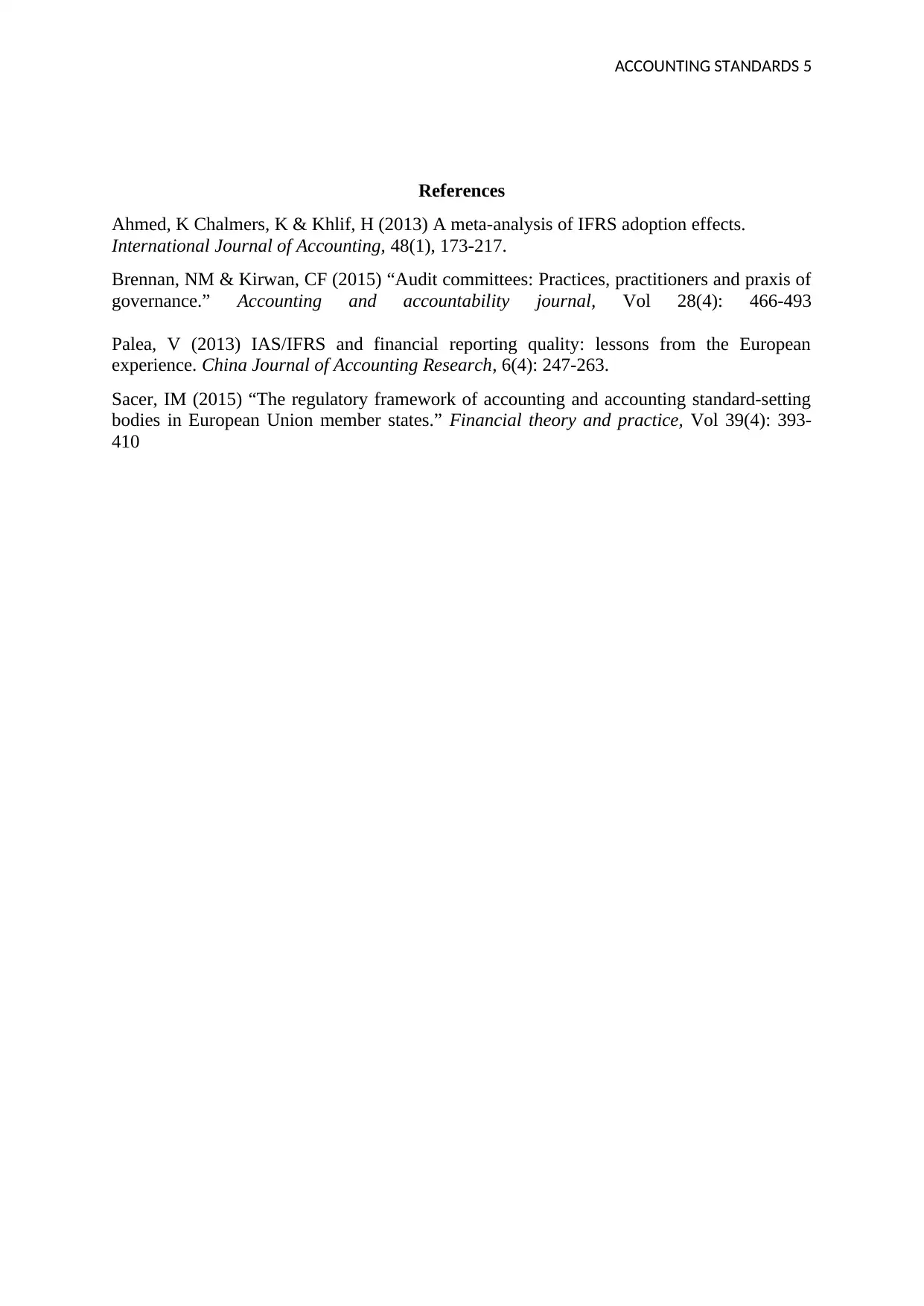
ACCOUNTING STANDARDS 5
References
Ahmed, K Chalmers, K & Khlif, H (2013) A meta-analysis of IFRS adoption effects.
International Journal of Accounting, 48(1), 173-217.
Brennan, NM & Kirwan, CF (2015) “Audit committees: Practices, practitioners and praxis of
governance.” Accounting and accountability journal, Vol 28(4): 466-493
Palea, V (2013) IAS/IFRS and financial reporting quality: lessons from the European
experience. China Journal of Accounting Research, 6(4): 247-263.
Sacer, IM (2015) “The regulatory framework of accounting and accounting standard-setting
bodies in European Union member states.” Financial theory and practice, Vol 39(4): 393-
410
References
Ahmed, K Chalmers, K & Khlif, H (2013) A meta-analysis of IFRS adoption effects.
International Journal of Accounting, 48(1), 173-217.
Brennan, NM & Kirwan, CF (2015) “Audit committees: Practices, practitioners and praxis of
governance.” Accounting and accountability journal, Vol 28(4): 466-493
Palea, V (2013) IAS/IFRS and financial reporting quality: lessons from the European
experience. China Journal of Accounting Research, 6(4): 247-263.
Sacer, IM (2015) “The regulatory framework of accounting and accounting standard-setting
bodies in European Union member states.” Financial theory and practice, Vol 39(4): 393-
410
1 out of 5
Related Documents
Your All-in-One AI-Powered Toolkit for Academic Success.
+13062052269
info@desklib.com
Available 24*7 on WhatsApp / Email
![[object Object]](/_next/static/media/star-bottom.7253800d.svg)
Unlock your academic potential
Copyright © 2020–2025 A2Z Services. All Rights Reserved. Developed and managed by ZUCOL.





